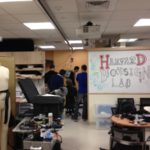Harvard Biodesign Lab, Cambridge
The Harvard Biodesign Lab brings together researchers from the engineering, industrial design, medical, and business communities to develop robots and smart medical devices that are specifically intended for interacting and cooperating with humans. Our work is accomplished through new approaches to design and fabrication of actuation and sensing components (e.g. using soft materials) in addition to the development of appropriate control strategies for systems that integrate these components. These technologies are inspired by the results of experiments in human biomechanics and their development is influenced by time spent in the operating room to understand the unmet needs from clinicians. Current research projects focus on wearable robotics to assist disabled and able-bodied people, as well as tools for minimally invasive diagnosis and treatment of disease. Lab members work closely with industrial partners and technical experts to translate these technologies into products that meet real-world medical needs.
Learn about our two Decals!
 Click here to find out more about our Fall Bioinspired Design Decal and our Spring Bioinspired Design in Action Decal – ALL MAJORS are welcome.
Click here to find out more about our Fall Bioinspired Design Decal and our Spring Bioinspired Design in Action Decal – ALL MAJORS are welcome.Berkeley BioDesign Community
 Click here to learn about the BioD: Bio-Inspired Design @ Berkeley student organization or here to signup for more info.
Click here to learn about the BioD: Bio-Inspired Design @ Berkeley student organization or here to signup for more info.Search
Student Login




I imagine that the neurological circuits underlying these processes are governed by both 2d spacing maps with their brains as…
to reduce the impact of car accidents, it may be possible to study the force diverting physics of cockroaches to…
you see this type of head-bobbing stability in many avian creatures related to pigeons like chickens. the head ability to…
not like they taught horses how to run! this is an example of convergent evolution where both sea creatures and…
The brain functions in a similar way with neuronal connections. our brains are able to utilize the multiplicity of connections…